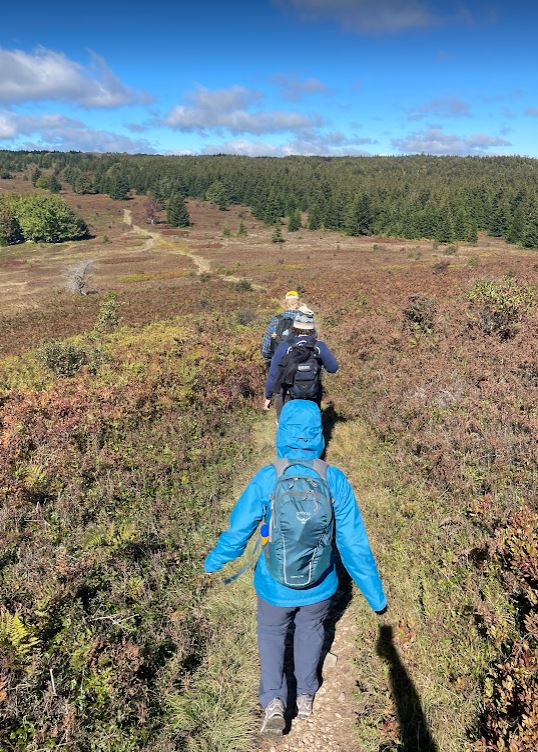Between thousands of acres of forested lands and the Blue Ridge and the Allegheny mountains, nature-lovers at Eastern Mennonite University have their pick of beautiful scenery and unique ecology.
In September, 14 students traveled two hours to experience one of the rarest ecoclimes on the east coast, Dolly Sods Wilderness Area in the Monongahela National Forest. On the agenda: hiking, rock scrambles, birding, caving, and fossil-hunting, with some downtime to relax and an evening around the campfire at Red Creek Campground.
Professors Doug Graber Neufeld and Jim Yoder, who teach biology and environmental sustainability, led the trip to West Virginia.
“We live and work in an amazing place with access to these public lands that are both our laboratory and our home,” Graber Neufeld said. “We wanted to give our students an opportunity to see some of that beauty, get away from campus, and do something fun in ecology without a test or homework hanging over them.”
The trip, with one- and two-night options, was open to all environmental sustainability majors and minors and any first-year student considering the major.
Ally Peachey, a sophomore majoring in environmental science and biology from Champaign, Illinois, says Dolly Sods made the list as one of her favorite wild places, along with the Upper Peninsula of Michigan. The eight-mile hike on the first day out was, she said, “some of the most beautiful hiking I have experienced,” she said.
Read more about ecology field trips and students hiking in Shenandoah National Park.


EMU hikers along the Bear Rocks Trail (right), surrounded by the unique “heath bald” habitat composed of huckleberry bushes and high altitude species of sedges and grasses as well as red spruce trees.
Northland loop trail, which travels through a forest of red spruce into a unique bog area.
“This unique ecosystem resembles a boreal forest from northern New England, Canada and even Alaska in many aspects, with lots of bogs and specialized plants, including the carnivorous sundew,” said Graber Neufeld.
The name Dolly Sods came from a homesteading family, the Dahles, and the local word for a meadow, “sods.” The history of human activity in the region includes eras of grazing, logging, burning and bombing. During World War II, the area was a practice artillery and mortar range. Only in the late ‘60s, under threat of development, was it eventually protected and restored. Read more about Dolly Sods.

Yoder (black vest) and Graber Neufeld (to the left) talk about the bogs on the Northland Loop Trail.
Hikers pause along the Raven Ridge Trail to view a beaver dam.
The EMU group poses for a photo in front of the Sinks of Gandy, a mile-long cave through a mountain. Here the group poses before tracing the path of the river into the mountain, wading and climbing over rock areas before climbing through a passageway and chambers to exit at the end. Rock formations and mineral deposits were a highlight, along with sightings of cave wildlife, including bats and spring salamanders.
Spelunking was a highlight of the weekend for Catherine Kirby, a junior environmental science major. Hailing from Loudoun County in northern Virginia, she says the nearby Blue Ridge mountains are a favorite wild place. The Dolly Sods trip gave her some great memories to return to campus with, especially the fellowship of “eating dinner together around the campfire.”

I first went here in the 50s as a teenager picking huckleberries with my family and have been here on numerous occasions with my own family. It’s a special place!!